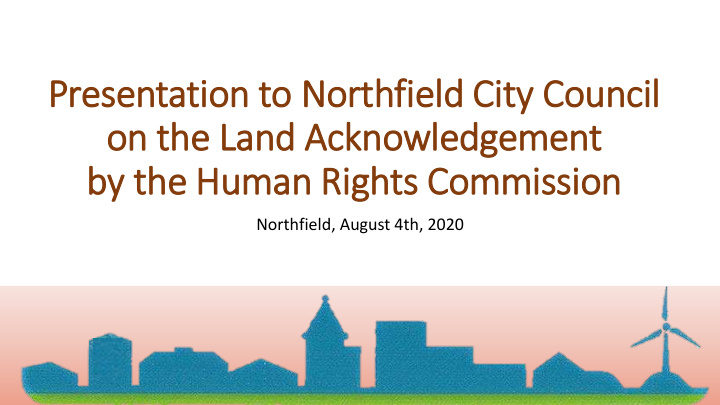



Presentation t to Northfield Ci City Co Council on the L Land Ac Ackn knowledgement by t the Hu Human Ri Rights C Com ommission Northfield, August 4th, 2020
Context for why we are doing this • The Human Rights Commission worked towards the Proclamation of the Indigenous Peoples´ Day approved by the Northfield City Council on October 2018. • St. Olaf racial protests in 2017 led Bruce King to work on a land acknowledgement since it was one of the students demands. • Carleton was also added to the conversation and Bruce King from St. Olaf and Joe Hargis from Carleton visited the Commission during the winter sessions in 2019 and subsequent subgroup of community and Human Rights members meetings. • St. Olaf adopted the Land Acknowledgement Statement on April 28,2020 approved by the Student Government Association. It appears in the St. Olaf History and Heritage webpage. https://wp.stolaf.edu/about/history/
What a Land Acknowledgement needs to be • It must include references to the past, present and future and cannot be timid addressing the injustices. • The statement should work to create relationships not as a performance. From Carleton College professor Meredith McCoy presentation to the Human Rights Commission: A Land Acknowledgement is: ● A formal statement from a city, province, state, institution of higher education, or other cultural institution that affirms and recognizes the Indigenous peoples of a particular place and their historic, ongoing, and future relationships with those lands and waters ○ Land acknowledgements recognize “the Indigenous peoples who have been dispossessed from the homelands and territories upon which an institution was built and currently occupies and operates in” (NYU). ● Rather than formulaic institutional statements, they should be processes of reflection and action
What a strong Land Acknowledgement should include From Carleton College professor Meredith McCoy presentation to the Human Rights Commission: ● Reflect, strengthen, and sustain relationships with Native nations ● Reflect, strengthen, and sustain commitments to lands, waters, plants, and animals ● Examine complicated histories of displacement and dispossession ● Truthfully state the history of the area, including histories of forced land dispossession ● Speak about Indigenous people in the present ● Commit to tangible action ● Are not the responsibility of Indigenous people
The Northfield Land Acknowledgement TRIBES/NATIONS IN MINNESOTA We stand on the homelands of the Wahpekute Band Bois Forte Band of Chippewa Fond du Lac Band of Lake Superior Chippewa of the Dakota Nation. We honor with gratitude the Grand Portage Band of Chippewa people who have stewarded the land throughout the Ho-Chunk Nation (of Wisconsin) Leech Lake Band of Ojibwe generations and their ongoing contributions to this Lower Sioux Community region. We acknowledge the ongoing injustices that Mille Lacs Band of Ojibwe we have committed against the Dakota Nation, and Prairie Island Indian Community Red Lake Nation we wish to interrupt this legacy, beginning with acts Shakopee Mdewakanton Sioux Community of healing and honest storytelling about this place. Upper Sioux Community White Earth Nation Carleton professors, Meredith McCoy and Michael McNally have suggested we additionally include the Mdewakanton (Dwellers of the Spirit Lake) name since the Shakopee Mdewakanton Sioux community is the band of the Dakota nation whose current territories are closest to Northfield.
We e nee eed to o tel ell the e com omple lete history of of this s regio egion Northfield´s history started with the original Dakota inhabitants of the area. We are on Dakota land. There is very little representation of the history prior to the European settlers in our City. The Land Acknowledgement is a step towards changing that. The Indigenous Peoples Day 2020 Celebration will recognize the true name of our river: Inya Bosndata, river of the Standing Rock. Detail from the Post Office Mural and the Wahpekute recognized in the drawing and banner
Ac Actions: B Building Connecti tions and Community The goal of our community is to build better connections with the Dakota and Ojibwe people in the state of Minnesota. We want to be intentional and find ways to build meaningful relationships through art, culture and history. Reviewing the past and making the connection with the present and future also means to review the names and relationships with past atrocities, including the Mankato massacre of 1862, when in December 26, 38 Dakota men were hanged, the largest one-day mass execution in American The Shakopee Mdewakanton (Dwellers of the Spirit of the Lake) history followed by April 1863 and the expulsion Government and Community Center Hoċokata Ti (The Lodge at the of the rest of the Dakota in the area. Center of the Camp) is open even during the pandemic. A must see to learn about the history of the Dakota people and a community often overlooked in history classes.
THANK YOU
Recommend
More recommend